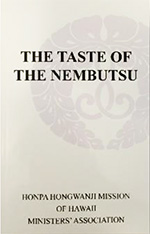
A message from Rev. Mariko Nishiyama which appears in the book, “The Taste of the Nembutsu,” published in 2016 by the HHMH State Ministers’ Association. The book is a collection of dharma messages by each of the active ministers.
To extend the reach of the dharma within these messages, we will publish one per week on our website.
Growing Up in the Nembutsu
Rev. Mariko Nishiyama
The Buddha said to Ananda,
Bear these words in mind.
To bear these words in mind
means to hold fast to the Name
of the Buddha Amitayus.
(Contemplation Sutra)
My dear friends of the dharma, over the past years, I have enjoyed wonderful opportunities sharing Hilo’s Buddhist history with members of Hilo Betsuin. I learned how they lived during the world wars and how the teachings of Shinran Shonin have been passed on for generations in Hawaii. There’s an old saying, in Japanese “Onkou Chi Shin.” which means that we study old things which we learned a long time ago and find out new meaning and doctrine from it. Hearing Onkou Chishin always has a great impact on me. And, I think that we all have had teachers along our life’s path who inspired us by deeply touching the core of our being. I remember the book which I once read, Hilo Hongwanji: RECALLING OUR PAST, a collection of oral histories. It begins with the story of Reverend Byakudo who came to Hilo Hongwanji in 1913. He was instrumental in building this temple in which members now gather for services. The story tells his tireless efforts exerted toward the growth of Hilo Hongwanji during its early history. Incidentally, the statue of Shinran Shonin in the front courtyard was donated in his memorial by his son and wife, Mr. Doro and Mrs. Betty Takeda.
The book continues with various “I remember when…” stories told by the Fujinkai members. They recall how the choir got started, what it was like to attend Japanese language school, and how lively and fun the bazaars were. Their descriptions of the events and activities reveal how much they enjoyed getting together to prepare for the different events. One person who shared her oral history was Mrs. Fusae Ito.
The following is my impression of Mrs. Fusae Ito, who passed away 2 years ago. She used to talk to me not only about her tsunami experience but also about volunteer work in the kitchen. Through her tremendous history, I could feel how the members spent their time listening to the teaching of Jodo Shinshu. Actually, most of us might not care to listen to the same story over and over, but I welcomed talking to her because I can never forget her ever-sparkling eyes. I felt as if she were Amida’s child, reflecting what Rennyo Shonin, the 8th Headmaster of the Hongwanji said, “Realize that the Nembutsu is our grateful response to the Buddha’s benevolence.”
The collection ends with the story of Mr. Frank Nagao, who worked long and hard for the preservation and protection of the temple during World War II. The temple facilities were used by the military as its headquarter, and Hongwanji members were not allowed on the premises. He tells of his year-long negotiations with the army for the reimbursement of costs to refurbish the facilities.
All of these stories together depict the past of Hilo Hongwanji from very personal points of view. Each past member was influenced by the teachings of the Nembutsu. Each member’s effort was an expression of the Nembutsu teachings, especially revealing interdependence. Each member’s story embodies the teachings as each protected or was influenced by their religious belief. Such deep entrusting led to enlightenment. Enlightenment led to awakening. Awakening resulted in gratitude to the Amida Buddha.
Listening to the teachings, we live each day fully and carefully now. So, everyone, bear these words in mind, “Please love deeply with Namo Amida Butsu in your heart and minds.” Namo Amida Butsu
